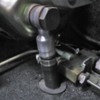i have already the part in my daily

everything must match, dia bolt and flexible.
Have cleaned it with some gasoline and air pressure.. could be "OK" again.
Another solution would be using it again for the booster connection and a supplementary "in-line".....we will see

no big problem.
I got today !!! my license plate

up till now i was still riding the UK plates / Insurance from the former owner. But there's a new law ,forbitten this and they hunt foreing plates...so i had to do something .One problem was the adjustable suspension, Ok, for now, but as you know i bought my Insurance with originals on spare..Bit embarresing for me , i did the wire transfer monday a week ago and Dave didn't see the payement yet ... now almost 2 weeks !!!! ..

I think they flying it over the pond bill by bill




